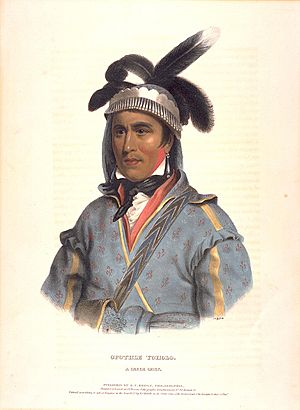Treaty of Washington (1826) facts for kids
The 1826 Treaty of Washington was an agreement between the United States and the Creek Nation. This treaty was led by Opothleyahola, a respected Creek leader. In this agreement, the Creek National Council gave up a large part of their land next to Georgia to the United States.
Contents
Understanding the Creek Nation and Their Lands
The Creek Nation was a group of different Native American communities. They had their own customs and histories. For many years, they had given up small parts of their huge lands to the United States through various treaties. The Creeks had even been allies with Great Britain during the War of 1812.
The Treaty of Fort Jackson
The Creek War ended in 1814 with the Treaty of Fort Jackson. This treaty forced the Creeks to give up about 23 million acres of their best land to the United States. This left the Creeks with only a small area around the Chattahoochee River. After this, the Creek Nation made a rule: giving away any more land without permission was a very serious offense.
Georgia's Desire for More Land
By the mid-1820s, leaders in Georgia wanted all Native Americans to move west of the Mississippi River. Democratic Governor George Troup was very determined to make this happen.
The Problem with the Treaty of Indian Springs
A smaller group within the Creek Nation, called the Lower Creeks, was led by William McIntosh. He was Governor Troup's cousin. On February 13, 1825, McIntosh and his group signed the Treaty of Indian Springs. This treaty gave a huge amount of Creek land to the United States.
However, most other Creek chiefs and warriors, especially the Upper Creeks, strongly disagreed with this treaty. They said that McIntosh and his group did not have the right to give away land for the entire Creek Nation. Because he broke Creek law about giving away land without permission, William McIntosh was killed on May 31, 1825.
A New Treaty for the Creek Nation
President John Quincy Adams did not think the Treaty of Indian Springs was fair or legal. He told Governor Troup to stop people from Georgia from moving onto Creek land.
Creek leaders then traveled to Washington, D.C. to talk about a new peace agreement. Many different Creek leaders came together under the leadership of Opothleyahola. They negotiated a new treaty with the United States.
What the New Treaty Changed
The new treaty officially canceled the Treaty of Indian Springs. It gave all Creek land east of the Chattahoochee River to the United States. In return, the Creeks received a payment of $217,600 and a yearly payment of $20,000.
The treaty also said that those who signed the Treaty of Indian Springs would have the same benefits as those who signed this new treaty. It also set aside money for the Lower Creeks (William McIntosh's group) to send five people to explore lands west of the Mississippi River. The United States would then pay for their move and provide food for a year. They would also provide a U.S. Indian Agent, an interpreter, a blacksmith, and a wheelwright. The treaty also paid for damages caused by the disagreements between McIntosh's group and the rest of the Creek Nation.
The Creeks were allowed to keep their lands until January 1, 1827. After that, they would only keep a small part of their land on the Alabama-Georgia border.
Signing and Final Changes
The treaty was signed on January 24, 1826. A few months later, on March 31, 1826, an extra article was added. This article fixed some mistakes and clearly marked the border between Georgia and the remaining Creek land. The United States also agreed to pay the Creek Nation an extra $30,000 for another piece of land in what is now Carroll County.
The Final Outcome
Governor Troup was not happy with the new treaty. He was under pressure from people who wanted more land. So, he ordered the land to be measured for a lottery, even the part that was supposed to stay with the Creeks.
President Adams tried to stop this by sending American soldiers. But Governor Troup called out the state militia. President Adams did not want a civil war, so he gave in. The United States government allowed Troup to quickly make a new agreement. This new agreement took all the remaining Creek land next to Georgia. By 1827, most Creek citizens were moved out of Georgia. Within eight years, most of them were moved from Alabama to the area called Indian Territory (which is now Oklahoma).


